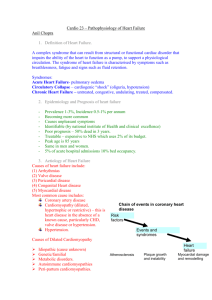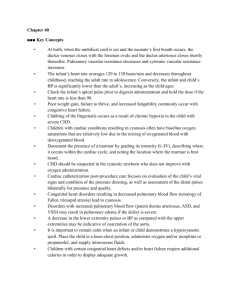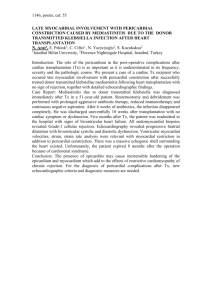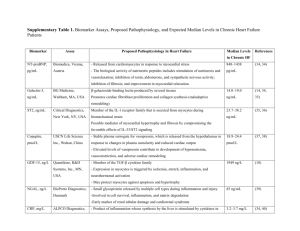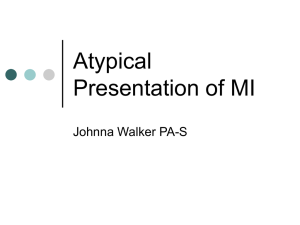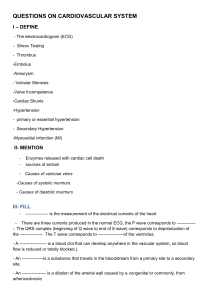PATHOLOGY OF THE HEART: ISCHEMIC HEART DISEASE
advertisement
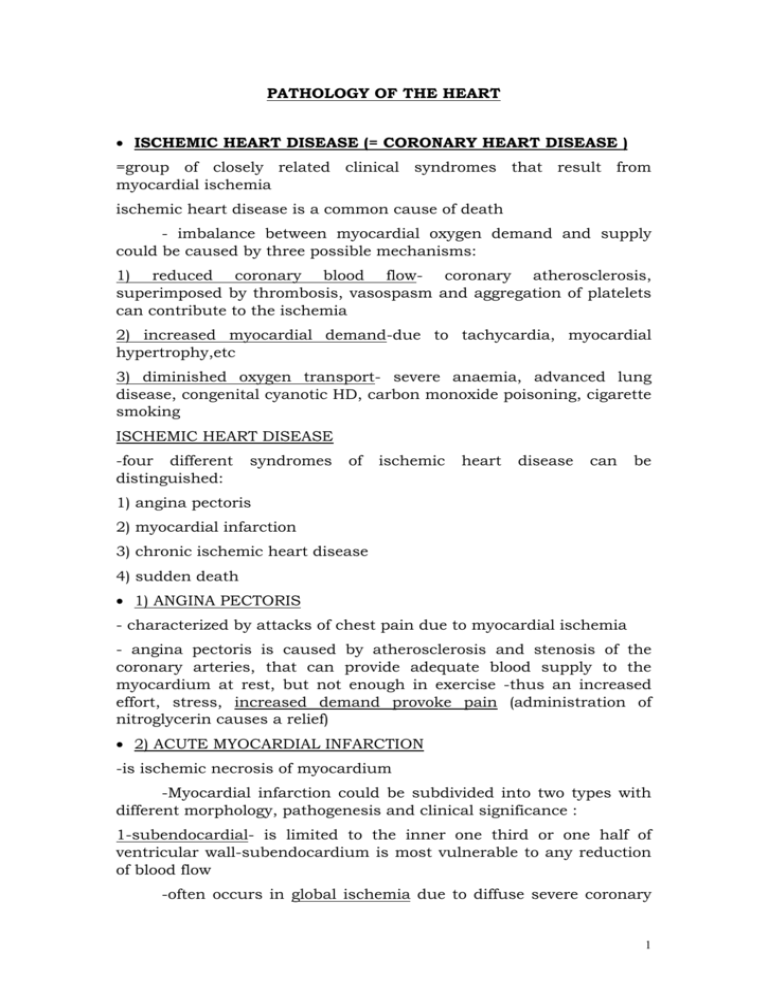
PATHOLOGY OF THE HEART ISCHEMIC HEART DISEASE (= CORONARY HEART DISEASE ) =group of closely related clinical syndromes that result from myocardial ischemia ischemic heart disease is a common cause of death - imbalance between myocardial oxygen demand and supply could be caused by three possible mechanisms: 1) reduced coronary blood flow- coronary atherosclerosis, superimposed by thrombosis, vasospasm and aggregation of platelets can contribute to the ischemia 2) increased myocardial demand-due to tachycardia, myocardial hypertrophy,etc 3) diminished oxygen transport- severe anaemia, advanced lung disease, congenital cyanotic HD, carbon monoxide poisoning, cigarette smoking ISCHEMIC HEART DISEASE -four different distinguished: syndromes of ischemic heart disease can be 1) angina pectoris 2) myocardial infarction 3) chronic ischemic heart disease 4) sudden death 1) ANGINA PECTORIS - characterized by attacks of chest pain due to myocardial ischemia - angina pectoris is caused by atherosclerosis and stenosis of the coronary arteries, that can provide adequate blood supply to the myocardium at rest, but not enough in exercise -thus an increased effort, stress, increased demand provoke pain (administration of nitroglycerin causes a relief) 2) ACUTE MYOCARDIAL INFARCTION -is ischemic necrosis of myocardium -Myocardial infarction could be subdivided into two types with different morphology, pathogenesis and clinical significance : 1-subendocardial- is limited to the inner one third or one half of ventricular wall-subendocardium is most vulnerable to any reduction of blood flow -often occurs in global ischemia due to diffuse severe coronary 1 AS but without superimposed thrombosis- transient global borderline perfusion made critical by an increased demand, vasospasm or hypotension 2-transmural- necrosis involves the full thickness of the heart wall -virtually all IM involve left ventricle, and interventricular septum grossly: occlusive thrombus can usually, but not always be identified in the coronary artery microscopically: the appearance of IM changes with time-2h- no changes -3-6h- changes may be visualized by the use of histochemic techniques, such as staining for dehydrogenases -more than 3h- early electron microscopic changes -6-8h- early light microscopic changes and after 24h- first macroscopic changes morphologic complications associated with IM: - papillary muscle infarction may cause a rupture and acute insufficiency of mitral valve - fibrinous and fibrinohemorrhagic pericarditis - mural thrombosis - rupture of the heart in the area of IM- causes massive cardiac tamponade - chronic ventricular aneurysm 3) CHRONIC ISCHEMIC HEART DISEASE = chronic progressive coronary atherosclerosis and progressive ischemic myocardial damage morphology: modest left ventricular dilatation, atherosclerosis of coronary arteries, and myofibrosis clinical course: slowly progressive disease- serious cardiac arrhythmia or IM may develop 4) SUDDEN CARDIAC DEATH = unexpected death from cardiac causes within 1-24h after the onset of acute symptoms -mechanism- malignant arrhytmia caused by ischemia CONGENITAL HEART DISEASES (CHD) Etiology: -in most cases of CHD -no identifiable cause 2 -they are very environmental inputs likely multifactorial with genetic and -in few patients, a specific cause can be identified, such as transplacental infection of the fetus by rubeola virus (1st trimester) -chromosomal abnormalities may be associated with CHD- high incidence of defects of the atrioventricular valves in Down syndrome -some drugs, such as thalidomide were shown to cause severe defects in the fetus including cardiac anomalies -fetal alcohol syndrom- due to high amounts of alcohol used during early pregnancy CLASSIFICATION OF CHD: -congenital heart anomalies are of two major types- shunts and obstructions shunts= abnormal communications between heart chambers, between large vessels or between chambers and vessels Common defects are classified according to: 1- which side of the heart is involved 2- whether there is a communication (shunt) between both sides 3- in the defect with shunt, if there is a cyanosis (= a bluish color of the skin and mucous membranes caused by increased amount of reduced hemoglobin in arterial blood obstruction= typically coarctation, valvular stenoses (partial occlusion) and atresias (complete occlusion). These do not cause cyanosis according to the major functional disorders, the CHD may be classified to three categories: 1 ) CHD with left-to-right shunts (=CHD with late cyanosis ) - these include interventricular and septal defects and patent ductus arteriosus -at early stage - these anomalies are without cyanosis, but the increased blood pressure in right side induces chronic right heart overload with pulmonary hypertension and right ventricle hypertrophy - results in reversal of the direction of blood flow-leads to a development of right-to-left shunt- means that unoxygenated blood is then shunted to the left heart-which causes „ late cyanosis“ 1. ATRIAL SEPTAL DEFECTS -is characterized by an abnormal opening in the atrial septum that allows free communication of blood - when less than 1 cm, it is well tolerated, even larger ASDs are 3 usually not detected until adult life, the problems appear with the reversal of the blood flow and cyanosis and right-sided heart failure 2. VENTRICULAR SEPTAL DEFECTS -is an abnormal opening in the ventricular septum that allows free communication between left and right ventricles - are among the most common CHD clinical significance of ventricular septal defects ( VSD) depends on the size of defect -large VSD are much serious with clinical manifestation in early life- strong left-to-right shunt causes an increased blood flowpulmonary hypertension- narrowing of the pulmonary arteries -small VSD - mild left-to-right shunt does not cause changes in blood flow, but the patients are in increased risk of infective endocarditis - surgical correction is advocated before right heart overload and vascular pulmonary disease develop 3. PATENT DUCTUS ARTERIOSUS - in the fetus, the ductus arteriosus is a normal fetal vascular channel that connects the pulmonary artery and the aorta - permitting to bypass the inactive fetal lungs - after the birth, the ductus closes spontaneously by muscle spasm within 1 to 2 days of life clinical significance: -even large PDA are initially asymptomatic, but later they cause a left-to-right shunt, pulmonary hypertension- reversal of blood flow, right-sided hypertrophy and right-sided heart failure - early surgical closure of a PDA is advocated 2 ) CHD with right-to-left shunts (=CHD with early cyanosis) - these include tetralogy of Fallot, transpositions of large heart arteries truncus arteriosus and - secondary finding in long-standing cyanotic HD induce clubbing of the fingers and toes, hypertrophic osteopathy and polycytemia 1. TETRALOGY OF FALLOT -is the most common cyanotic CHD -it is characterized by -large ventricular septal defects -dextroposed aorta overriding the ventricular septal defect -stenosis of the pulmonary tract with RV outflow obstruction 4 -hypertrophy of the right ventricle Cyanosis is present from birth-because the stenosis of pulmonary artery causes right-to-left shunt from the very beginning (early cyanosis) -„blue babies“ severity of clinical symptoms is directly related to the extent of RV outflow obstruction - mild pulmonic stenosis and large VSD produces only mild leftto-right shunt without cyanosis - more severe pulmonary stenosis produces a cyanotic right-toleft shunt, right-sided hypertension appears-causing right-to left shunt with hypoxemia, dyspnea, and cyanotic or hypoxic symptomsfinely pulmonary hypertension appears -with complete pulmonic obstruction, survival is permitted only by blood flow through a patent ductus arteriosus prognosis is very poor without treatment-surgical repair or at least partial correction is now possible in all cases 3 ) CHD with obstruction of blood flow without cyanosis these include coarctation of the aorta, aortic valvular stenosis and pulmonary valvular stenosis 1. COARCTATION OF THE AORTA =represents narrowing or stenosis of the aorta clinical manifestation obstruction- depends on location and severity of two types of the coarctation of the aorta preductal type of coarctation - manifests early in life and may cause rapid death -survival depends on the ability of the ductus arteriosus to sustain blood flow to the distal aorta and to the lower body adequately- even then- severe lower body cyanosis- often associated with fetal RV hypertrophy and early right heart failure postductal type -the „adult type“ because this type of anomaly is generally asymptomatic untill adult life -it usually leads to hypertension in the upper extremity, but weak pulses and low blood pressure in the lower extremities- causes arterial insufficiency-often claudications and coldness of the lower extremity -collateral flow around stenosis of the aorta develops- with mammary and axillary arteries dilatation surgery: if untreated- life span is 40 years- death is due to aortic dissection proximal to coarctation, intracranial hemorrhage, or 5 infective endocarditis at the site of narrowing surgical resection of the affected portion of the aorta and replacement by a prosthetic graft prevents these complications ENDOCARDIAL AND VALVULAR DISEASES among acquired valvular diseases, the most important are 1) CALCIFIC AORTIC VALVE STENOSIS =represents 90% of acquired aortic stenoses, these are degenerative, age-related lesions etiologically associated with AS, morphology: grossly- calcified masses within the sinuses of Valsalvae, that cause thickening and fibrosis of the aortic valve with narrowing of the orifice clinically: CHF due to LV hypertrophy and ischemia- because the process may cause a narrowing of proximal parts of coronary arteries 2) POSTRHEUMATIC HEART DISEASE ( RHD) -results from consequencies of acute rheumatic fever= is an acute nonsuppurative inflammatory immune-mediated disease that follows 2-3 weeks after acute streptoccocal pharyngitis -acute bacterial infection initiates a production of antibodies that cross react with myocardial and endocardial cells and with other cells of the body- resulting in a process of autoimmune tissue destruction -in acute rheumatic fever - many organs may be affected, including the heart- all layers may be involved in myocardium- acute myocarditis- characterized by presence of Aschoff bodies- composed of focal fibrinoid necrosis of collagen, scattered lymphocytes and plasma cells and Aschoff giant epithelioid histiocytes in the endocardium- the disease affects particularly the valves- in acute inflammation- the involved valves show edema, endocardial damage and rheumatic vegetations (composed of fibrin and platelets, and debris), in chronic phase- rheumatic endocarditis heals by fibrosis- Mc Callum patch= focal fibrotic scar of the free endocardium in the posterior wall of the left atrium -fibrosis of the affected valve- causes a narrowing of the orifice= valve stenosis or severe destruction of the valve-may cause rigid dilatation=valve incompetence -the mitral valve is most commonly affected (aortic valve, less 6 often the valves of right heart) the joints - infection affects mostly large joints, tend to migrate from joint to joint basal ganglia of the brain- causes so called chorea- involuntary movements skin lesions subcutaneous rheumatic nodules- consist of fibrinoid necrosis surrounded by a rim of granulation inflammatory reaction 3) INFECTIVE ENDOCARDITIS -colonization of heart valves with microbes in severe bacteriemia leads to formation of friable infected thrombi (vegetations) and to destruction of the valve ACUTE INFECTIVE ENDOCARDITIS caused by highly virulent agents that can even attack previously normal valves-severe bacteriemia -large vegetations cause embolic complications with metastatic abscesses in many organs. The disease typically presents as a rapidly developing fever with rigor and severe weakness SUBACUTE INFECTIVE ENDOCARDITIS more common, caused by organisms with lower virulence, infection usually affects previously damaged valves (chronic RHD, CHD, prosthetic valves, degenerative valve diseases) clinically low grade bacteriemia, fever. This disease tends to have a protracted course. morphology: damaged valves are covered by infected thrombi (=vegetation)- consist of collections of leukocytes, bacterial colonies, fibrin, cellular debris -vegetations- are large, soft, friable, possible subject of embolism- systemic embolism- infarction in the brain, kidney, spleen mycotic aneurysm= infected embolus causes weakening of the affected artery wall- formation of the aneurysm= miliary microabscesses clinically: -bacteriemia- blood culture positive for bacteria -fever-most common feature -splenomegaly-due to activation in chronic bacteriemia (phagocytic and endothelial cell hyperplasia in the spleen) -valvular dysfunction- cardiac myocardium (abscess, perforation) murmurs or injury to -systemic embolism -spleen, kidney, brain- including the 7 metastatic infections MYOCARDIAL DISEASES. -diffuse heart disease can be separated to two major groups 1) myocarditis - diffuse diseases of the heart characterized by inflammatory reaction 2) cardiomyopathy -diffuse non-inflammatory myocardial diseases MYOCARDITIS =inflammatory disease of the myocardium characterized by rapid onset of clinical symptoms, such as arrhythmias or various ECG changes -usually most patients recover quickly but in some of them years later, chronic heart failure (due to dilated cardiomyopathy) -most cases are of viral origin - particularly coxsackie viruses, influenza, cytomegalovirus- cardiac involvement occurs several days to a few weeks after a primary virus infection at another site -noninfectious myocarditis- may be immune mediated, for example myocarditis associated with rhematic fever, SLE, drug allergies, sarcoidosis -idiopathic myocarditis- no infectious agent is found giant cell myocarditis, Fiedler myocarditis -rarely of bacterial origin- often secondary in patients with bacteriemia (staphylococcal) in severe cases of myocarditis- chronic heart failure due to dilated cardiomyopathy develops CARDIOMYOPATHY =the term implies a noniflammatory diffuse myocardial disease that is not related to pressure or blood volume overload, not included rheumatic heart disease, ischemic heart disease, congenital diseases etc. cardiomyopathy can be divided into three clinicopathologic categories: 1) dilated (congestive) CMP 2) hypertrophic CMP 3) restrictive ( obliterative ) CMP 1) Dilated CMP -is characterized by marked gradual heart chamber dilatation and hypertrophy with an disorder in contractile function that lack any signs of myocarditis 8 - the clinical course is slow and progressive to CHF - dilated CMP represents the end stage of a variety of myocardial disorders- such as -the heart damaged by viral infection- end stage of viral injury to myocardium CMP due to chronic alcohol abuse- alcohol has been shown to induce regression changes within the myocardium - attributed to direct toxicity of alcohol or to chronic thiamine deficiency CMP due to cardiotoxic drugs, including adriamycin, daunorubicin, heavy metal, such as cobalt and lithium) clinical course: -prognosis is poor, because dilated CMP represents a progressive chronic heart disease with poor contraction ability and markedly reduced cardiac output -death due to fatal arrhythmia or of systemic embolism from mural thrombi, or of progressive CHF 2) HYPERTROPHIC CMP -is characterized by subaortic septal thickening that causes narrowing of the aortic outflow -the disease may be familial and is transmitted by autosomal dominant inheritence morphology:- cardiac enlargment (great increase in weight) disproportionate myocardial hypertrophy -most evident in the left ventricle and interventricular septum -on cross section- the left ventricular cavity may be compressed by hypertrophic septum into the banana-like shape, bulging septum into the left ventricle cavity clinically: hypertrophic CMP occurs most often in young adults- there is an increased risk of sudden death -the course of hypertrophic CMP is highly veriable most patients with mild CMP improve or remain unchanged for years, only in minority of patients the course is rapid 3) RESTRICTIVE (OBLITERATIVE) CMP - is the least common type of CMP is heterogenous group of diseases, such as cardiac amyloidosis, sarcoidosis, endocardial fibroelastosis, endomyocardial fibrosis and Loeffler endocarditis common to all: -reduced ventricular elasticity and reduced diastolic filling of the heart chambers and thus reduced cardiac output 9 PERICARDIAL DISEASES - almost always associated with disease in the heart, rarely pericardial involvement may occur as a primary process Accumulation of fluid in pericardial sac may include 1.) pericardial effusion 2.) hemopericardium 3.) pericardial exudate 1.) pericardial effusion-the normal pericardial sac contains 30 to 50 ml of serous fluid non-inflammatory fluids serous-most common form -serosa is smooth and glistening, -fluid accumulates slowly and therefore it is well tolerated untill very large amount about 500 ml is formed most common causes hypoproteinemia are congestive heart failure or in 2.) hemopericardium- accumulation of blood in the pericardial sac without inflammatory component most common causes are - rupture of myocardium in IM - follows trauma - rupture of the intrapericardial part of the aorta - or due to hemorrhage from the cancer metastases 200-300 ml may cause death- because the blood escapes rapidly and produces cardiac tamponade 3.) pericardial exudate- due to inflammation -usually secondary to disorders involving the heart (IM, trauma, tumors) or due to systemic diseases (uremia, autoimmune diseases) acute pericarditis serous- in rheumatic fever, uremia, tumors, SLE, primary viral origin -the fluid resorbs completely without any residues fibrinous or sero-fibrinous- the most common form, typically occurs in IM -exudate may be completely resolved or be organized leaving typically delicate, stringy adhesions= adhesive pericarditis purulent- in fungal, bacterial or parasitic infections -presents with prominent fever, rigors, fraction rub usually organizes 10 and may produce constrictive pericarditis hemorrhagic-denotes an exudate admixed with blood -most commonly associated with TBC or cancer -may organize by collagen formation with secondary hyalinization and dystrophic calcification caseous pericarditis- due to TBC usually by direct extension from infected lymph nodes chronic pericarditis adhesive- fibrous plaques („milk spots“) on the visceral pericardium or adhesions between both two layers of the pericardium -pericardial sac may be obliterated, the heart contracts with difficulties- results in heart hypertrophy and dilatation constrictive- uncommon chronic pericarditis, that is finally characterized by encasement of the heart in a greatly thickened fibrotic pericardium -the pericardial sac is complitely obliterated -reduced is right atrial filling- elevation of blood pressure in large veins -results in enlargment of the liver and ascites TUMORS OF THE HEART AND PERICARDIUM 1) Cardiac myxoma - is a benign tumor of the endocardium- very rare, occurs almost entirely in the atria -is composed of small stellate cells embedded in an abundant myxoid extracellular matrix clinical features: -include fever, weight loss, anemia ( unexplained) -systemic embolism, heart murmur, possible cause of sudden unexpected death due to an acute prolapse of the tumor mass into atrioventricular orifice which causes acute obstruction of circulation 2) Rhabdomyoma - the most common primary heart tumor in children (very rare) grossly- gray-whitish ventricular mass microscopically- composed of large polygonal eosinophilic cells of stellate shape- „spider cells“ secondary tumors of the heart- more common (site of primary tumor- ca of lungs, breast, malignant melanoma, lymphoma, leukemia) 11
